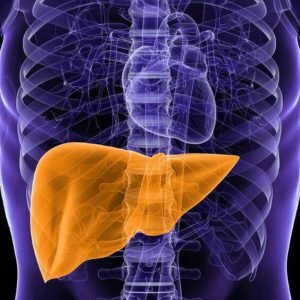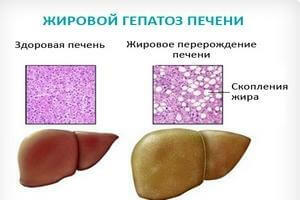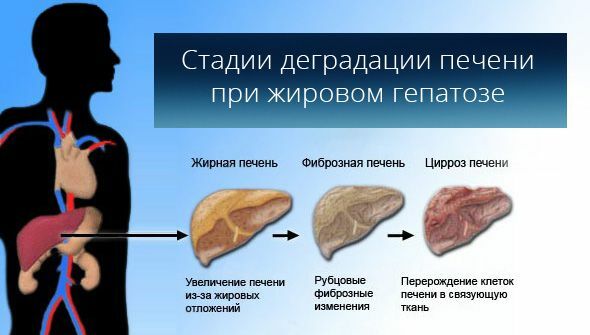Toxic and adipose hepatosis: symptoms and treatment

Hepatosis is a group of liver diseases, the basis of which is the disturbance of metabolic processes in the liver tissues and the development of pathological changes in them.There are several different types of hepatosis, which will differ in both the nature of the course and the symptomatology.
Table of contents:Classification of hepatoses
In medicine, two major forms of the disease under consideration are acquired: hereditary hepatoses, which also have some division into species.
Acquired hepatoses
These are pathologies that develop in a person in the process of life under the influence of a factor not associated with genetic defects.Acquired hepatoses include:
-
 Toxic hepatosis.It can be provoked by certain medicines, poisons and toxins.It is not necessary for this to regularly use arsenic or inhale carbon monoxide - it is enough to work in harmful production or to undergo a course of treatment, for example, from dysentery or diphtheria( toxic medicines are meant).
Toxic hepatosis.It can be provoked by certain medicines, poisons and toxins.It is not necessary for this to regularly use arsenic or inhale carbon monoxide - it is enough to work in harmful production or to undergo a course of treatment, for example, from dysentery or diphtheria( toxic medicines are meant). - Fatty hepatosis.This is a chronic liver disease, which is caused by pathological degeneration of liver cells( hepatocytes) with internal or extracellular fat deposition.
Fatty hepatosis can be caused by alcoholism and obesity.An important role in the development of the fatty species of the disease under consideration is played by the thyroid gland, for example, the probability of diagnosing fatty hepatosis is much higher in people with diabetes and any endocrine disorders.

Hereditary hepatoses
Here everything is simple - pathology is caused by a defect in the genes. This form of the disease under consideration includes:
- Gilbert syndrome is a violation of bilirubin binding in liver cells.
- Rotor Syndrome - a violation of the transport of bilirubin in liver cells.
- Dabin-Johnson syndrome is a violation of bilirubin transport in the liver cells, which is accompanied by the accumulation of a large amount of pigment in them.
It should be separately noted that the symptoms of liver hepatosis in the above diseases can only appear if there are factors that led to a worsening of the condition:
- Gilbert's syndrome:
- recovery period after any surgical interventions;
- prolonged course of acute respiratory-viral diseases and influenza;
- a low-calorie diet or fasting;
- excessive physical activity;
- alcohol intake;
- stress psycho-emotional origin.
- Rotor and Dabin-Johnson Syndrome:
- prolonged body temperature rise against the background of colds and flu;
- psychoemotional stress;
- excessive physical activity;
- alcohol intake;
- the use of anabolic steroids.
Symptoms of hepatosis
The most commonly diagnosed is fatty hepatosis - we begin by describing the symptoms of this particular species.Patients will complain of dragging pain in the right hypochondrium, which appears periodically and is of a non-intensive nature.Periodically, the patient may experience nausea and vomiting, often there are disorders of the stool( diarrhea).
Toxic hepatosis will have very different symptoms:
- jaundice of skin and eye proteins;
- increase in body temperature to 40 degrees;
- marked nausea and multiple vomiting;
- diarrhea;
- darkening of urine;
- severe pain in the right upper quadrant.
If we talk about hereditary hepatosis, then they will have the same clinical picture:
- occasionally causes icteric skin and eye whites;
- occasionally causes severe itching of the skin;
- marked decrease in appetite, up to total refusal of food;
- increased fatigue;
- blunt aching pain in the right hypochondrium;
- bitterness in the mouth.
Note: even such characteristic symptoms do not entitle the physician to diagnose hepatosis.In order to confirm their assumptions, specialists conduct a full-fledged diagnostic examination.
Diagnostic measures for the suspected hepatosis
They will be necessarily comprehensive, it is also meant to conduct a complete examination of the patient. Diagnostic measures for suspected diseases include:
-
 Anamnesis of the disease and complaints - how long have the symptoms occurred, with which the patient can connect them, what does he usually eat, what medications the patient takes or takes, how much is usedalcohol.
Anamnesis of the disease and complaints - how long have the symptoms occurred, with which the patient can connect them, what does he usually eat, what medications the patient takes or takes, how much is usedalcohol. - Anamnesis of the patient's life - whether he is sick with alcoholism, whether there are transferred diseases of the endocrine system.
- Family history analysis - are there any relatives with hepatitis and other liver diseases?
- Examination of the skin - the doctor will select the yellowing of the skin and eye proteins, the presence of vascular asterisks, when probing the liver, the specialist will determine the soreness and enlargement of the organ, pancreas and spleen.
- Laboratory tests:
- clinical blood test;
- biochemical blood test;
- coagulogram;
- general analysis of urine;
- blood test for the presence of viral hepatitis;
- coprogram;
- feces analysis for helminth eggs.
Separately, it is worth paying attention to instrumental studies - they, in most cases, allow you to make a final diagnosis. To instrumental studies in the diagnosis of hepatosis include:
-
 Ultrasound examination of the abdominal cavity to assess the condition of the gallbladder, liver, biliary tract, kidneys, pancreas, intestines.
Ultrasound examination of the abdominal cavity to assess the condition of the gallbladder, liver, biliary tract, kidneys, pancreas, intestines. - Computerized tomography of abdominal organs for a more detailed assessment of their condition.It is computer tomography that makes it possible to identify difficult-diagnosed tumors, lesions and nodes of the liver.
- Esophagogastroduodenoscopy - the doctor will be able to assess the condition of the esophagus, stomach and duodenum.
- Liver biopsy - sampling of a fragment of liver tissue for histological examination, which allows not only to make an accurate diagnosis, but also to exclude tumor processes.
Only after receiving the results of a complete examination the doctor can prescribe the treatment of hepatoses.
General principles of treatment of hepatoses
Naturally, therapy is selected individually, but there are some general principles of treatment of the disease in question.
In the treatment of toxic hepatosis is meant:
- immediate hospitalization of a patient in a hospital;
- abolition of all drugs that have caused poisoning;
- hemosorption and plasmapheresis - procedures that allow the removal of toxic substances from the bloodstream;
- treatment of hepatic insufficiency, hepatic encephalopathy( complications of hepatosis) with the help of antibacterial and analgesic medications.
Obligatory in the treatment of toxic hepatosis, doctors are carrying out prevention of hepatic coma.
If fatty hepatosis was diagnosed, the main areas of treatment will be as follows:
- correction of the diet;
- combating alcoholism( total refusal of use);
- reception of enzymatic drugs for improving digestion;
- administration of hepatoprotectors;
- reception of hormonal and anti-inflammatory drugs.
Note: is a fatty hepatosis and proceeds and is treated much more easily than the toxic form of the disease under consideration.For the treatment of fatty hepatosis the patient is not placed in a hospital, but leads him on an outpatient basis.
All hepatoses of the hereditary form of any specific treatment do not require.Doctors recommend only to eat rationally, keep to a diet and refuse to take alcohol, anabolic steroids.
Diet for hepatoses
A very important role in the treatment of hepatoses is played by diet.If it is severe in the toxic form of the disease under consideration, then, for example, with a fat one, it is milder and more gentle.
Diet for hepatosis implies compliance with certain rules:
- It is necessary to exclude from the diet fried and spicy food, seasonings and carbonated drinks.
- Buckwheat and oat porridge, vegetable stews( they should not be fried, but stewed), various casseroles will be very useful.
- All dishes are highly desirable to cook in the oven - for example, meatballs and cutlets should not be fried, and baked in a light white sauce, cabbage rolls should prefer a casserole of vegetables with minced meat and so on.
- You can not use a patient with diagnosed hepatosis to consume saturated broths from meat or vegetables, so when cooking soups you need to prepare "secondary" broths.
- You can not go hungry at all, but at the same time you can not overeat.You need to distribute your food so that the number of meals a day is at least 5 times.
- You should stop using flour products - biscuits, cookies, cakes, pies and any buns are banned.You can use a dry biscuit and crackers.
Note: refusal of alcohol when diagnosing any type of hepatosis is an undesirable measure!
Traditional medicine in the treatment of hepatoses
Of course, traditional medicine can offer a lot of funds for the treatment of liver hepatoses.Some of them will really be of use, but in no case should they become a priority in the choice of therapy.It should be remembered that any folk remedies should be additional to drug therapy.
Pumpkin medicine
 It is necessary to prepare a ripe pumpkin of round shape - cut off the "cap" with a tail and a spoon to remove all seeds with fibrous pulp.The resulting pumpkin vessel should be filled with honey and cover the vegetable with a "lid".Pumpkin filled with honey, is removed to a dark place for 14 days, only you need to make sure that the air temperature in the room was not lower than 20 degrees.
It is necessary to prepare a ripe pumpkin of round shape - cut off the "cap" with a tail and a spoon to remove all seeds with fibrous pulp.The resulting pumpkin vessel should be filled with honey and cover the vegetable with a "lid".Pumpkin filled with honey, is removed to a dark place for 14 days, only you need to make sure that the air temperature in the room was not lower than 20 degrees.
After two weeks, the honey should be completely drained from the pumpkin and stored in the refrigerator.A take this drug should be 1 tablespoon three times a day.
Note: pumpkin honey should be taken a month, then a break for 2 weeks is made and the course is repeated.The total duration of treatment with this remedy is 6 months.
Herbal collection
It is necessary to prepare an herbal collection of 12 different medicinal plants:
- birch leaves and licorice roots - 4 parts each;
- rose hips, hawthorn and red-billed mountain ash - 3 parts each;
- leaves of nettle, cowberry and bearberry - 2 parts each;
- roots of althea, dandelion, fennel fruits and St. John's wort - 1 part each.
All components must be crushed and mixed.Then take 2 tablespoons of the finished raw material, and pour 1, 5 liters of boiling water, leave in a thermos for 8-10 hours( it is convenient to prepare the product for the night).The received volume of infusion should be drunk during the day, and the general course of treatment is 1-6 months( all depends on the dynamics of the disease).
Hepatosis - a dangerous disease that rapidly turns into cirrhosis of the liver, can lead to liver failure.It is important not only to diagnose hepatosis, but immediately begin treatment, or at least to give up alcohol and adjust the diet.
Tsygankova Yana Aleksandrovna, medical reviewer, therapeutist of the highest qualification category



